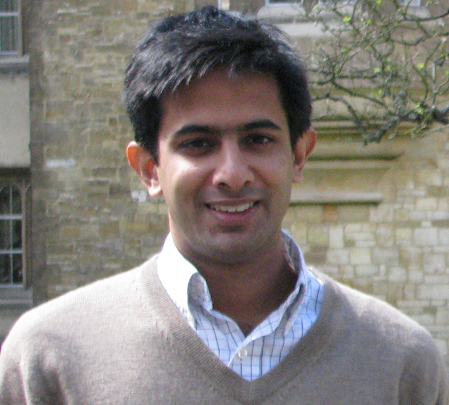Young Researchers
(in alphabetical order)

Dr. Arat Kalra
Postdoctoral Scientist at Princeton University, New Jersey, USA.
At present, Aarat Kalra studies the interaction of light with biological polymers called microtubules. Dr. Kalra’s work has shown that microtubules can transport electronic energy over nontrivial distances, and microtubules lower their local pH value compared to the rest of the solution. He received his Ph.D degree from the University of Alberta, M.Sc. from McGill University, and B.Sc from Dayalbagh Educational Institute.
“All Wired Up: Exploring Photonic and Ionic Signalling in Microtubules“
Abstract
The brain consumes about 20 W of power to operate, but this input results in all sensory experience. Does such a high efficiency result from processing only biochemical stimulus, or do brain cells also process light and electricity? We address this question by investigating how intracellular protein polymers respond to such nonchemical stimuli. Here, we start by performing experiments on slender, tubelike microtubules, which act as ‘fencing posts’ for the cell. Microtubules play a variety of well researched roles: they maintain cell shape and rigidity, orchestrate cell division and are crucial for cell movement. We understand if, in addition to these roles, microtubules can direct photonic and electrical energy to different parts of a cell. Previous work has shown that microtubules respond nontrivially to electric fields, perhaps allowing them to play intracellular electrical signaling roles (1). Devices using electrical stimuli for medical applications have also been modeled to target microtubules (2). My own work as a graduate student started experimental work in this direction, showing that microtubules dramatically lower local pH values by electrostatically attracting protons to their outer surface (3). In addition to electrical stimuli, light has been shown to cause changes in intracellular biochemistry (4). My postdoctoral work shows that the fluorescence properties of microtubules change upon interacting with biochemical agents. Such behaviour indicates that these polymers may not act simply as rudiments of the cell’s skeleton, but rather as channels for signaling using electricity and light. This work on microtubules will illustrate the relevance of nonchemical information processing within cells, and in so doing, provide mechanistic insight into how the brain works.
- Kalra AP, Eakins BB, Patel SD, Ciniero G, Rezania V, Shankar K, et al. All Wired Up: An Exploration of the Electrical Properties of Microtubules and Tubulin. ACS Nano. 2020;14(12):16301-20.
- Davies AM, Weinberg U, Palti Y. Tumor Treating Fields: A New Frontier in Cancer Therapy. Annals of the New York Academy of Sciences. 2013;1291(1):86-95.
- Kalra AP, Eakins BB, Vagin SI, Wang H, Patel SD, Winter P, et al. A Nanometric Probe of the Local Proton Concentration in Microtubule-Based Biophysical Systems. Nano letters. 2021.
- Hamblin MR, Huang Y-Y, Heiskanen V. Non-mammalian Hosts and Photobiomodulation: Do All Life-forms Respond to Light? Photochemistry and Photobiology. 2019;95(1):126-39.

Dr. Ami Kumar
Columbia University, Department of Neurology, Irving Medical Center, New York, USA.
Ami Kumar is a postdoctoral scientist at the department of Neurology, Columbia University, New York, USA. Ami Kumar completed her Ph.D. from Kiel University, Germany and M.Sc. from Dayalbagh Educational Institute, Agra in the field of Neurosciences.
Her current research involves developing new therapeutic pipelines for neuromodulation in movement disorders such as ataxia and tremor, using non invasive brain stimulation techniques.
“Cerebellar Neuromodulation in Movement Disorders“
Abstract
Movement disorders such as tremor and ataxia, are devastating neurological conditions that affect a large number of people. The clinical features of ataxia include incoordination, imbalance, and irregular movements, while tremor is associated with rhythmic and oscillatory movements. These movement disorders are linked with dysfunction of the cerebellum in the brain. Treatments for these disorders involve pharmacotherapy; however, these remain limited, and often unsatisfactory. As a new approach brain stimulation has been an upcoming focus of research in order to better understand cerebellar pathophysiology and its involvement in movement disorders.
Non-invasive brain stimulation approaches such as transcranial direct current stimulation (tDCS) and transcranial alternating current stimulation (tACS), are techniques that modulate brain oscillations by sending a small current across the scalp. Studies have shown the successful modulation of brain oscillations and the improvement of symptoms, in movement disorders using stimulation. Cerebellar stimulation in movement disorders may lead to insights on cerebellar physiology and pathology, further leading to the advancement of therapeutics for such disorders.

Dr. Shiroman Prakash
Dayalbagh Educational Institute, Department of Physics and Computer Science, Assistant Professor, Agra, India
Shiroman Prakash completed his M.Sc. in Physics from Indian Institute of Technology, Kanpur, and his Ph.D. in Physics from Tata Institute of Fundamental Research, in theoretical physics.
His research interests include string theory, quantum field theory and quantum information/computation.
“Implications and Applications of Quantum Contextuality”
Abstract
In this talk we will discuss implications that research in quantum computing – particularly the subject of fault-tolerant quantum computing – has for scientific and philosophical questions associated with consciousness.
Quantum mechanics is the most successful scientific theory ever proposed, remaining unfalsified after over a century of experimental tests of ever-increasing rigor. Quantum mechanics is also mysterious and counter-intuitive. Some aspects of quantum mechanics, such as the uncertainty principle and the measurement problem, are self-evident from the initial applications of the theory to atomic physics. However, in the decades since its discovery, researchers in quantum foundations have learned that quantum mechanics is fundamentally different from classical physics in ways that aren’t immediately obvious.
John Preskill describes quantum computing as “putting weirdness to work.” Computers that make full use of quantum physics are known as quantum computers – and are, in theory, able to solve certain specific computational tasks much faster than classical computers.
Fault-tolerant quantum computing concerns the practical question of how to build a large- scale quantum computer that can preserve and process information stored in delicate quantum superpositions in despite ever-present environmental noise. To make sure the task is no more challenging than absolutely-necessary, we must understand exactly what kind of quantum “weirdness’’ we need (and how much of it we require) to achieve a quantum speedup. Over 50 years ago, Kochen, Specker and Bell identified contextuality as a fundamental difference between classical and quantum mechanics. Unlike the uncertainty principle and the measurement problem, contextuality remained obscure, barely mentioned in any quantum mechanics textbook and unknown to most physicists. However, in recent years, quantum computing researchers have identified and began to quantify contextuality as the essential resource for quantum computation.
What are the implications for the interpretation of quantum mechanics? While some of the weird features of quantum mechanics – observer-dependence and the uncertainty principle
– could conceivably be eliminated by modifying and reformulating the theory, contextuality is a mathematical property of the probabilities that quantum mechanics predicts. Any observer-independent reformulation or deterministic modification of quantum mechanics that agrees with experiments must reproduce probabilities that exhibit at least some form of apparent contextuality – and one can argue that this would make such an observer- independent reformulation practically unintelligible. Contextuality is thus the essential reason why quantum mechanics is best understood as a first-person theory, reminding us that we cannot forever ignore our own existence as conscious observers participating with the universe.
“Do biological systems, such as brains, show quantum behavior?” is another difficult question to answer. Brains are hot, humid and noisy, so, at first glance, the answer seems to be no. But brains are also extremely fine-tuned over billions of years of evolution, capable of doing remarkable things, and widely accepted to be the most complex systems known to us. Moreover, our understanding of quantum information is still evolving, and only a few decades ago, many physicists thought quantum-error correction was impossible. So, for many scientists, the question remains open. But how can we experimentally demonstrate quantum brain biology? One hope is that a deeper understanding of contextuality can lead to unambiguous signatures of quantum behavior, though much work remains to be done.

Dr. Apurva Ratan Murty
Massachusetts Institute of Technology, McGovern Institute for Brain Research
Apurva Ratan Murty is currently a Research Scientist at the Center for Brains, Minds, and Machines, McGovern Institute of Brain Research, Massachusetts Institute of Technology with Nancy Kanwisher and Jim DiCarlo.
He is broadly interested in understanding the neural basis of visual object recognition in humans and non-human primates. He obtained his PhD from the Centre for Neuroscience, Indian Institute of Science, Bangalore – India, where he was advised by S.P. Arun. Over the course of his research at IISc, he investigated the dynamics of invariant object representations in macaques. In 2021 he received two awards –the NIH K99/R00 ‘Pathway to Independence’ from National Eye Institute, and the Young Systems Scientist Award – National Systems Society of India. His latest publication is: Ratan Murty, N.A., Bashivan, P., Abate, A., DiCarlo, J., Kanwisher, N. (2021). Computational models of category-selective brain regions enable high-throughput tests of selectivity. Nature Communications 2021, 12:5540. https://doi.org/10.1038/s41467-021-25409-6
“Computational models of conscious visual perception”
Abstract
The last quarter century has provided extensive evidence that some regions of the human cortex are selectively engaged in processing a single specific domain of information – from faces, places, and bodies to music, language, and other people’s thoughts. This work dovetails with earlier theories in cognitive science highlighting domain specificity in human cognition, development, and evolution. But despite decades of work on these regions, we still do not have a computationally precise understanding of what visual information encoded in these regions, and many questions still remain unanswered about even the clearest cases of specificity and conscious awareness in the brain. In this talk I will describe a series of experiments that challenge previous accounts of conscious perception and move us towards a more computationally precise account of visual intelligence as implemented in the human brain.